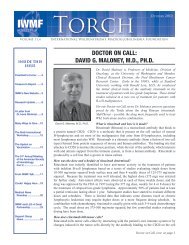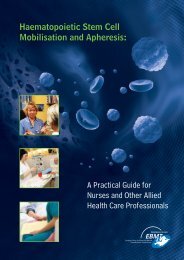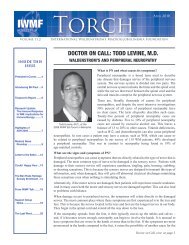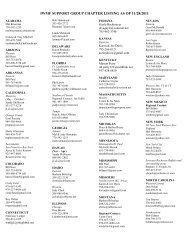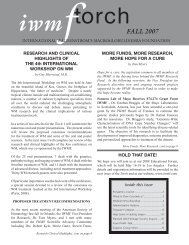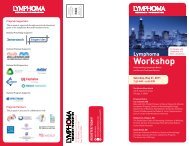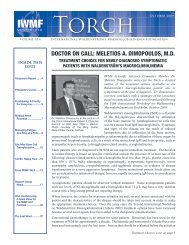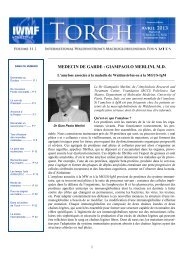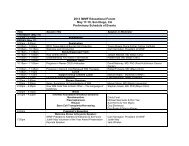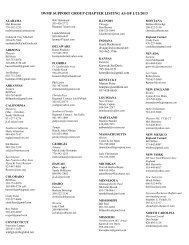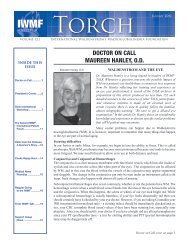English - International Waldenstrom's Macroglobulinemia Foundation
English - International Waldenstrom's Macroglobulinemia Foundation
English - International Waldenstrom's Macroglobulinemia Foundation
Create successful ePaper yourself
Turn your PDF publications into a flip-book with our unique Google optimized e-Paper software.
ASH Highlights, cont. from page 14<br />
from 30 age-matched healthy patients were collected. At low<br />
concentrations, a significantly greater amount of natural killer<br />
cell activation was observed with ublituximab, regardless of<br />
patient group. A phase I/II trial with single agent ublituximab<br />
in patients with rituximab relapsed/refractory non-Hodgkin’s<br />
lymphoma, including WM patients, is now underway.<br />
CLINICAL TRIALS<br />
Preliminary results from a Phase I dose-escalation study of<br />
MLN0128 (INK128) were reported by Dr. Irene Ghobrial,<br />
et al. in a multi-center study. This drug is an oral inhibitor<br />
of the mTOR complexes 1 and 2 (TORC1/2). The study<br />
included relapsed/refractory multiple myeloma, non-<br />
Hodgkin’s lymphoma, and WM patients, who received the<br />
drug either daily or for 3 days on and 4 days off each week,<br />
in 28-day cycles. The dose was escalated based on toxicities<br />
exhibited in cycle 1. The maximum daily tolerated dose was<br />
determined as 6 mg, while the maximum tolerated dose for the<br />
3 day-per-week schedule has not yet been defined. Overall,<br />
89% of patients had a drug-related event, including nausea,<br />
fatigue, hyperglycemia (high blood sugar), thrombocytopenia<br />
(decreased platelets), mucosal inflammation, vomiting, and<br />
anemia; 57% of patients had dose reductions/modifications<br />
and 27% discontinued treatment. Among 27 patients<br />
evaluated for responses, most were MM patients – two of<br />
the three WM patients enrolled had stable disease at this<br />
preliminary point.<br />
Dr. Meletios Dimopoulos, et al. from the Greek Myeloma<br />
Study Group produced a final analysis of a Phase II study<br />
of dexamethasone, rituximab, and cyclophosphamide (DRC)<br />
for the primary treatment of WM. Between November 2002<br />
and April 2006, 72 WM patients were enrolled in this trial,<br />
which consisted of dexamethasone IV and rituximab IV<br />
on day 1 and oral cyclophosphamide on days 1-5. DRC<br />
courses were repeated every 21 days for six courses, and then<br />
patients without progressive disease were observed without<br />
further treatment. Eighty three percent of patients achieved a<br />
response, including 7% complete, 67% partial, and 9% minor<br />
responses. The study was updated in June 2012 to assess<br />
time to progression, time to next treatment, type and response<br />
of second-line treatment, overall survival, and cause-specific<br />
survival. Second line treatment was administered to patients<br />
who experienced progressive disease and met criteria for retreatment.<br />
The median time to progression was 35 months,<br />
and the median time to next treatment was 51 months. Among<br />
several factors analyzed for correlation with shorter time to<br />
progression, only lymphadenopathy (enlarged lymph nodes)<br />
was significant. Among 40 patients who received secondline<br />
treatment, 28 were re-treated with either rituximab alone,<br />
with DRC, or with rituximab combined with other agents;<br />
the remaining 12 patients were treated with alkylating agents,<br />
nucleoside analogues, bortezomib, or high-dose (autologous<br />
stem cell transplant) therapy. So far, 35 patients (49%) have<br />
died, including 15 patients from unrelated causes. One<br />
patient who received therapy with fludarabine developed<br />
myelodysplastic syndrome, which is ineffective production<br />
of the myeloid blood cells; two patients developed diffuse<br />
large B-cell lymphoma (one after DRC and one after multiple<br />
treatments including alkylating agents and fludarabine). The<br />
median overall survival and cause-specific survival were<br />
95 months and 104 months, respectively. So far, DRC<br />
has not been associated with development of secondary<br />
myelodysplasia.<br />
Dr. Mathias J. Rummel, et al. reported on a multi-center<br />
study in Germany and Austria of bendamustine and rituximab<br />
(BR) therapy for newly diagnosed WM patients, followed by<br />
either observation or by rituximab maintenance. Treatment<br />
consisted of a maximum of six cycles of BR administered<br />
every 28 days plus two cycles of rituximab every four weeks.<br />
Responding patients were randomized to observation or to<br />
two years of rituximab maintenance every two months.<br />
At this time, 116 of 162 WM patients were evaluable for<br />
response; the overall response rate to the initial therapy was<br />
86%. Also, 43 patients are being observed and 47 patients<br />
are receiving rituximab maintenance therapy, but results<br />
are not yet available to report from this part of the trial. No<br />
uncommon toxicities were observed during initial therapy.<br />
A multi-center Phase I trial of bortezomib (Velcade) and<br />
alvocidib (flavopiridol) was reported by Dr. Beata Holkova,<br />
et al. The study enrolled 43 patients with multiple myeloma<br />
and non-Hodgkin’s lymphoma (including 2 WM patients)<br />
with recurrent or refractory disease. This trial was based<br />
on pre-clinical studies suggesting that cancer cells may be<br />
particularly sensitive to simultaneous interruption of cell<br />
cycle and survival signaling pathways. Alvocidib is a cyclindependent<br />
kinase inhibitor that interacts with bortezomib,<br />
and the primary objective of this trial was to identify the<br />
maximum tolerated dose for this treatment combination.<br />
Both drugs were given as intravenous infusions. Toxicities<br />
included dehydration, diarrhea, fatigue, anemia, loss of<br />
appetite, neutropenia (decreased neutrophils), lymphopenia<br />
(decreased lymphocytes), peripheral neuropathy, and<br />
thrombocytopenia (decreased platelets). Of the 43 patients<br />
treated, 38 have been evaluable for response; response<br />
rates were 33% for non-Hodgkin’s lymphoma and 35% for<br />
multiple myeloma. Patients are still being enrolled, and the<br />
maximum tolerated dose has not yet been reached.<br />
Dr. Anna Guidetti, et al. treated relapsed/refractory<br />
lymphoma patients with a combination of the oral AKT<br />
inhibitor perifosine with the oral multikinase inhibitor<br />
sorafenib. This Phase II Italian clinical trial enrolled 40<br />
heavily pretreated patients (including one WM patient)<br />
and started with a 4-week treatment of perifosine alone to<br />
assess tolerability and tumor response. Patients achieving<br />
less than a partial response were given the combination<br />
therapy until disease progression or significant toxicity. The<br />
most common toxicities were anemia, thrombocytopenia<br />
(decreased platelets), diarrhea, and joint pain. The results<br />
ASH Highlights, cont. on page 16<br />
IWMF TORCH Volume 14.2<br />
15



